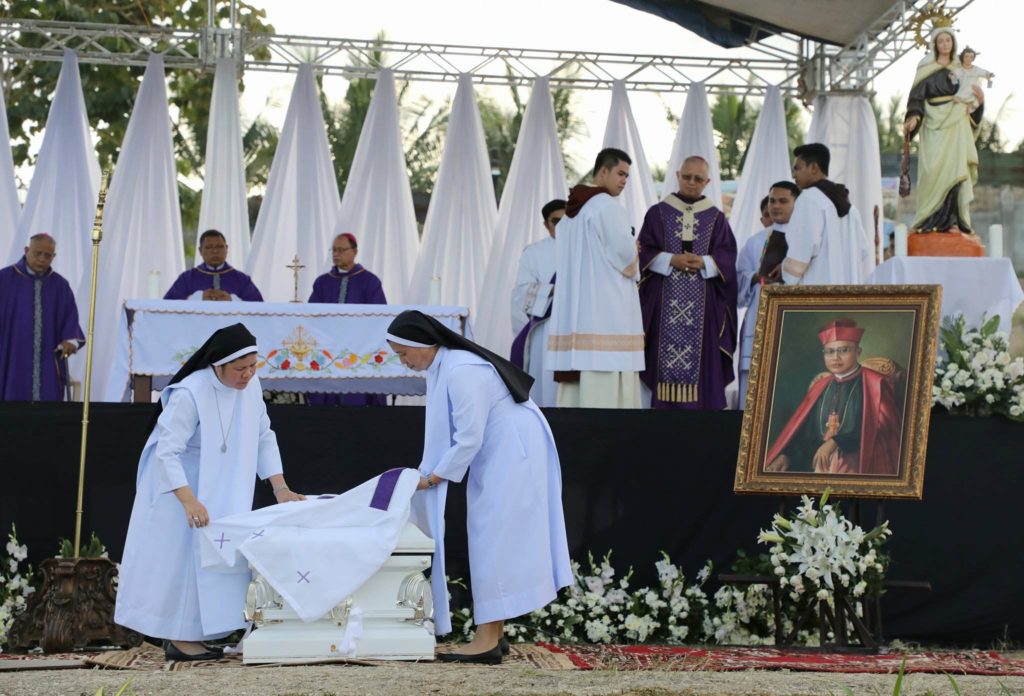The body of the late Archbishop Teofilo Camomot may have decomposed.
However, forensic experts noted two uncommon aspects about the prelate’s remains.
“On opening the wood casket, the remains and clothes of the decedent was noted to be in pristine condition, uncorrupted by any form of infestation and insect activity. There was a remarkable absence of foul smell and odor of decay,” said Dr. Erwin Erfe, head of the forensic team that examined the skeletal remains of Camomot.
“In my 15 years as forensic-anthropologist, this is the first time I encountered something like this. This is something unique,” he added.
“Usually, there is an odor of decay whenever we examine remains even decades after the death of the person. And usually, the remains are infested with insects considering that the coffin is made of wood. In the case of Archbishop Camomot, there’s no foul smell and its remains were neither infested with insects.”
Erfe said it is now up to the Vatican’s Causes for the Congregation of Saints to determine whether or not to declare Camomot a saint, not just based on its remains, but on the virtues lived by the well-loved prelate who is now a candidate for sainthood.
The skeletal remains of Camomot were exhumed on Wednesday and interred at the Domus Teofilo (House of Teofilo) in Barangay Valladolid, Carcar City on Thursday afternoon after a Mass was celebrated by Cebu Archbishop Jose Palma.
Camomot’s remains were placed on a fiber glass effigy and laid on a white coffin which was sealed by Palma.
At least 5,000 persons trooped to the Daughters of St. Teresa (DST) compound in Carcar City where Camomot’s remains were interred.
In his homily, Palma called on the people to pray unceasingly to the Lord as the Archdiocese of Cebu continues the stringent process for the beatification and canonization of Camomot.
“We thank the Lord for giving us Monsignor Lolong. By God’s will, may he be declared a saint soon. May God bless our hopes,” he told the crowd during the open air Mass at an open space inside the DST compound.
Palma said calls for the canonization of Camomot started even after the latter’s death in 1988. However, at that time, the Cebu archdiocese was still processing the sainthood of Visayan martyr Pedro Calungsod.
When Calungsod was declared a saint in 2012, the archdiocese immediately petitioned the Vatican to allow the local church to process the cause of sainthood of Camomot who was known for his extreme generosity and love for the poor.
“Thanks be to God, the process is moving fast,” Palma said.
Last Nov. 2017, the Vatican’s Congregation for the Causes of Saints has approved the diocesan process for the cause of sainthood of Camomot.
The diocesan process includes gathering of documents and writings of Camomot as well as the testimonies of witnesses who had personal encounters with the archbishop.
The next part would be the preparation of the Positio which would summarize the life and virtues of Camomot.
While the Church works on Camomot’s cause, Palma encouraged the faithful to not just pray but also to emulate the lofe and virtues of the Cebuano prelate.
“Even over 30 years after his death, Monsignor Lolong’s life is still relevant. He encountered the Messiah in the sacraments, the poor, and his simplicity of life. He became the refuge of many people. And so let us strive hard to somehow imitate him,” he said.
Concelebrating with Palma during the Mass were Cebu Auxiliary Bishop Oscar Florencio, retired Bishop Emilio Bataclan, and Apostolic Nuncio Emeritus of Korea Archbishop Osvaldo Padilla.
Also present were Fr. Samson Silloriquez, the Rome-based postulator of Camomot’s cause for sainthood; Fr. Mhar Vincent Balili, the vice postulator; and at least 30 priests.
Last Wednesday, Camomot’s remains were exhumed from ita tomb at the DST compound for forensic examination which is part of the process for sainthood.
Dr. Erfe said the skeletal remains of Camomot showed that the late archbishop died of “multiple, bilateral rib fructures, left calvicular fructures, and extensive cranial and bilateral facial bone fractures.”
He said the archdiocese took the fourth, left rib that was close to Camomot’s heart to be as a relic or a tangible item for veneration in case the late archbishop will be beatified or canonized.
Camomot’s body was first exhumed from the public cemetery in Carcar City in 2009, and was transferred to the compound of the DST, a congregation that he founded.
Camomot, fondly known as Monsignor Lolong, was known for his exceptional love for the poor.
In some instances, the Carcar City native pawned his episcopal ring and pectoral cross (the large crucifix worn by bishops) and gave the proceeds to the poor. The archbishop would also give away whatever he had to the needy.
Camomot died in a vehicular accident in San Fernando town on Sept. 27, 1988. He was 74.
The Archdiocese of Cebu ruled that the heroic virtues demonstrated by Archbishop Camomot are worthy of sainthood.
If soon canonized, Camomot will become the third Filipino saint after St. Lorenzo Ruiz and Calungsod./# # #
